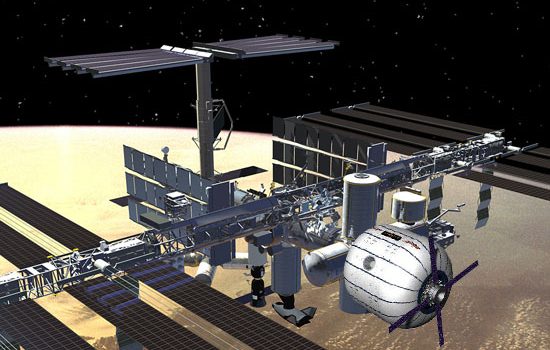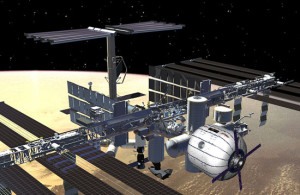

The Bigelow Expandable Activity Module (BEAM) on the ISS as it should appear in 2016 (Credits: NASA).
Bigelow Aerospace and NASA have signed a $17.8 million contract that could bring an inflatable module to be attached on the International Space Station.
NASA spokesman Trent Perrotto told Space News that the deal was signed in late December 2012, but he did not reveal the terms of the agreement, saying only that it centers on the Bigelow Expanded Aerospace Module (BEAM).
Although the details will be revealed later, it can be supposed that BEAM would be an inflatable addition to ISS, proving out the technologies and paving the way for future commercial space stations. The deployment of the module will represent a perfect demonstration for habitation and storage in a space environment, giving also significant data on the duration of inflatable modules compared to the existing metallic ones. According to NASA officials, the agency will ask one of its Commercial Resupply Services contractors, SpaceX or Orbital Sciences Corp., to carry BEAM to the ISS, most likely before the end of 2016.
Bigelow Aerospace, situated in Las Vegas, Nevada, has been in the space station business for several years, having deployed two orbiting prototypes called Genesis 1 and 2 in 2006 and 2007 respectivley, both launched with Russian rockets. In 2010, Bigelow won a nonpaying contract with NASA to develop a list of procedures and protocols to add BEAM to ISS. The company is now growing after a period of downturn, opening new facilities and hiring again to increase the working force up to 90 staff. Bigelow specializes in inflatable space habitat technology that it aquired from NASA. The company has aspirations to open a Commerical Space Station using the modules.
Meanwhile in Russia, RSC Energia has signed an important contract with Roscosmos to develop a draft design for for OKA-T-MKS, an orbiting unmanned lab to be connected to International Space Station. It seems clear that the ISS partners want to capitalize on the remaining funded life of the station as much as possible. ISS is currently expected to remain operational though at least 2020.
Below, the concept for a commercial Bigelow space habitat using the CST-100 capsule:

















































































































![A trajectory analysis that used a computational fluid dynamics approach to determine the likely position and velocity histories of the foam (Credits: NASA Ref [1] p61).](http://www.spacesafetymagazine.com/wp-content/uploads/2014/05/fluid-dynamics-trajectory-analysis-50x50.jpg)



Leave a Reply